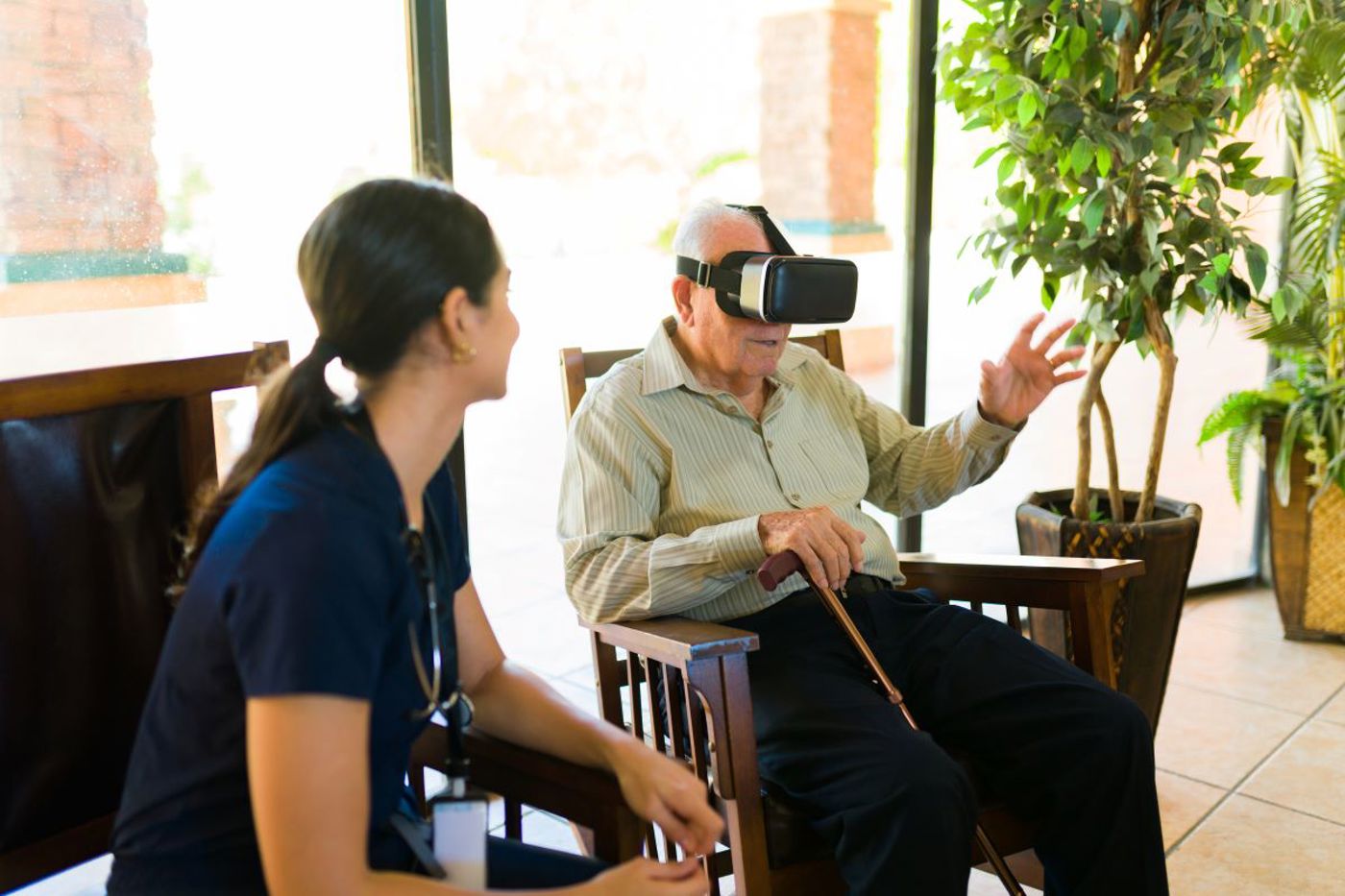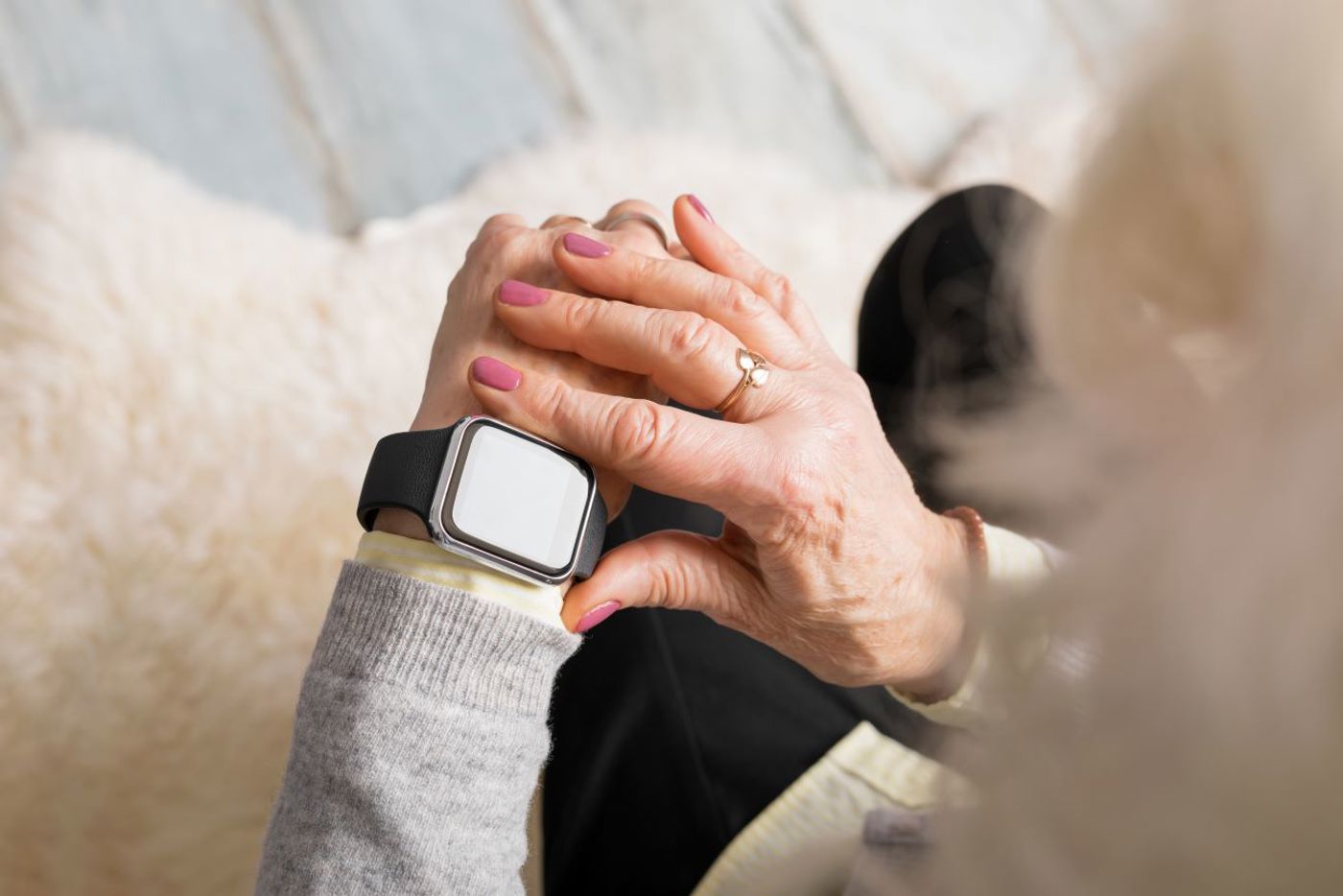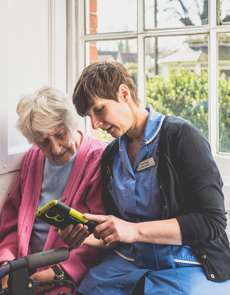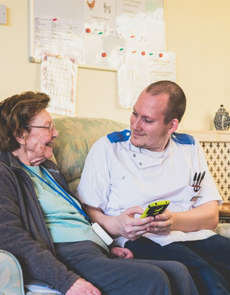Technology in Care Homes – 9 Digital Innovations in Care Homes You Need To Know About
Technology in care homes is an enormous topic, with more technology available than ever, all vying for your attention and your budget. Innovation in care homes has been a bit of a slow starter, but is now increasing in pace all the time.
As a care home operator you might sometimes feel a bit overwhelmed at all the different options. It can be tough to figure out which piece of technology will help you with that challenge, what kind of impact that technology will make, and how big that impact will be.
In short, which piece of care home technology is right for you, right now?
Examples of digital innovation in care homes
If you’re interested in the best technology for your care home, or nursing home then you’re in the right place. In this article I’ll give you an overview of some of the best technology, including digital technology in care homes right now.
I won’t bore you with all the complicated details, I’ll cut through the chaff and give you the information you need to decide if each piece of tech is something worth looking into further and maybe implementing into your services.
At The Access Group we provide care home management software to thousands of residential care services all over the UK. This gives me a window into technology and innovation in care homes. But, don’t worry, I won’t just be focusing on our products, or digital technology. I’ll give you the best overview of some really innovative technology right now, to help you make real improvements to your care services.
Digital Innovation In Care Homes
Digital innovation in care homes is constantly growing and evolving, and you’re probably aware of some of the more common examples, especially electronic care records.
In line with the government’s aim to get 80% of CQC registered care providers using digital records by 2024, you should be looking to get your care records digitized. But there is plenty of information of the benefits and available systems online already.
So in this article I’m going to focus on some breakthrough or lesser known examples that should enrich your understanding and maybe get you better prepared for what’s coming down in the track in the next months and years.

Virtual Reality In Care Homes
Virtual reality headsets might be most familiar to us from viral videos of vertigo stricken dads and people hopelessly flailing at nothing, but some care homes are experimenting with virtual reality in really interesting ways.
For example a care home in Oxfordshire has been trialing VR combined with physiotherapy, guided by a physiotherapist to virtually visit ‘sentimental locations’ such as the Devonshire coast and exercise.
Many care homes, including Signature Care Homes who have locations across the UK are using virtual reality to support reminiscence therapy for people with dementia and Alzheimer’s.
A team member at one of Signature’s care homes described their experience with it:
The technology used was a VR Oculus headset. One app lets you go anywhere in the world and puts you in that location. The possibilities are endless with the headset; they can attend concerts – front seats of course! There is so much they can do. Family and relatives can give us information of childhood addresses, schools, holidays etc.
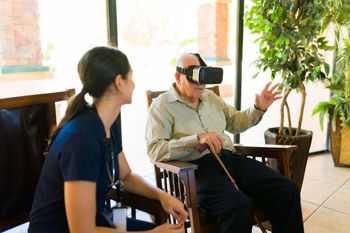
There is not an established body of evidence showing VR provides a significant boost to reminisence therapy, but where it is tried and appropriately used it does have a positive impact, as Dr Caroline Pooter of the Oxford Institute of Population Ageing writes:
“Conversations ensued (with encouragement from project team members) about residents’ experiences of the virtual worlds, which sparked reminiscence for some about places where they’d lived or visited. The most enthusiastic residents encouraged others to try VR, with a few even taking over the tablet to select the content for their friends.”
“Social engagement continued when the movement element was introduced, with residents encouraged to describe what they saw as they ‘walked’ (sliding their feet on a portable mat from a seated position) in the virtual environment. Feedback on the distance covered was motivating for some residents, who pushed themselves to ‘walk’ further than last time or further than their peers.”
“Care home staff fed back that the level of engagement was exceptionally high for some residents, although on any given day the numbers varied, with quite a few declining to participate or observing only. Residents with physical impairments seemed to especially enjoy and benefit from the virtual walking experience, as their ability to go on real-world walks was very limited. For them the VR technology did seem to provide ‘the world at your feet’, as promoted by the technology developers.”
For many, perhaps yourself VR may be a bit of a luxury, when compared to more practical solutions involved with care management and delivery. There are also ethical considerations around residents being drawn into a virtual world, as a substitute for an engaging, activity filled real world.
However, keep your eyes peeled. As more care homes pilot VR and academics conduct proper studies, we may see that real benefits are possible with VR, and the best ways to avoid negative side effects,
Acoustic Monitoring
Acoustic monitoring uses devices that measure differences in the levels of noise in a resident’s bedroom, to detect and alert staff to signs of:
- Choking or coughing
- Trying to get in/out of bed
- Unusual levels of restlessness
- A person asking for assistance
- Falls
The Department of Health and Social Care’s white paper ‘Health and social care integration: joining up care for people, places and populations' has set an aim for over 20% of all care homes in England to have acoustic monitoring solutions in place by March 2024.
Why? Well, acoustic monitoring has a number of key benefits. Even when it was first introduced in quite a basic form, it could help staff respond more quickly to a person in any sort of difficulty.
For example, by stopping them falling out of bed when they were calling for help, instead of only finding they had fallen when checking on them or through the use of pressure mats.
Acoustic monitoring solutions reduce disruption of residents’ sleep and because staff need to do far less checking in on residents, they can instead spend time on other activities.
Now that the power of data, artificial intelligence and even machine learning (which I delve into in more detail below) are being utilized, the benefits of acoustic monitoring are even wider reaching.
For example information gathered from acoustic monitoring processing data to identify patterns or changes in a person’s routine or behaviour, that could offer early warnings of deteriorating health, or indicators that occur before an incident such as a fall.
The expansion of other digital innovation in care homes, including digital care records, medicine systems, sensors, wearables and assistive technology can all feed into a data formed picture of a resident. Now, this is not the complete portrait of the individual, it won’t replace their personal wants and preferences.
What it can do is use these many sources of information to identify otherwise unseen signs and patterns. This information can be used to help prevent worsening health, make proactive, preventative interventions, suggest changes to how care is delivered or even change medicines that could be having adverse side effects. It’s all about giving people more information so they can make better decisions about their care.

Interactive Me
InteractiveMe is an interesting app that although not the most hi-tech or future orientated innovation on my list, it is one that is widely used in care homes, readily available and not too much of a headache to implement from what I can tell.
InteractiveMe enables care homes to deliver occupational therapy services via a mobile/tablet based app to their residents.
A session on InteractiveMe involves a range of ‘interaction triggers’ including personal photos, music, stories all relating to the individual’s life. It also features information about their favourite food, sports and life histories. All to help the individual reconnect with who they are in an interactive, more gentle way.
As with reminiscence therapy this kind of approach can be very effective for people with dementia or alzheimers. It can help people communicate, reduce anxiety, challenging behaviour and encourage meaningful interactions and socializing.
The system has received positive feedback from lots of leading care home groups and a few mentions in CQC inspection reports, that highlight the use of the technology under the ‘Responsive’ domain.
Wearables
You may have a Fitbit, Apple Watch or something like it, or at least know someone that does. I know personally that they really motivate you to stay active throughout the day and increase your fitness.
Wearables (devices we wear) are now being increasingly used, modified and trialed in care homes too. Like everyone else older people benefit from reminders and goals to increase their fitness.
But wearables have additional benefits for them too. For those with dementia wearables can double up as a failsafe GPS tracker, if a person leaves the care home and gets lost (an all too frequent problem) then staff can find them much more easily.
Wearables can already collect data on our heartrate, skin temperature blood oxygenation levels and other interesting health measures.
For some residents, you could build fitness goals and outcomes into their care and support plans based on what they would like to improve and what they are comfortable with. I know, and you probably do too, how empowering and rewarding it is to achieve these kinds of goals.
Exercise and achievement is also great for mental health and a fantastic way to get people interacting and supporting each other, sometimes with a bit of friendly competition.
For older people they can also have wider health benefits of course, strengthening the body, improving balance (and reducing fall risk), even reducing/managing the risk of heart conditions, stroke, diabetes and other medical issues that can really have an impact on a person’s wellbeing.
Tech companies are now working to make more specialist devices to support remote monitoring of more complex conditions, particularly as part of virtual wards. But more advanced or specialized wearables could be so useful in residential care too.
We could use them to detect early warning signs of health problems, blood sugar levels, or even consciousness and unconsciousness. Health data from wearables can become part of the wider data picture of a person, including information from electronic care plans and records, acoustic monitoring and other devices.
All this data can then be processed using machines learning (which I’ve covered in more detail below) or by people in reports and dashboards, to identify trends, patterns, improvements or signs of deterioration. We can then all make more informed interventions and help residents lead healthier more fulfilling lives.
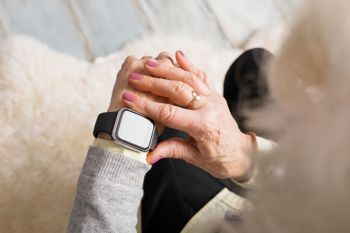
Reach out to find out more about our care home software to support your organisation
Circadian Lighting
Improved lighting can help reduce hazards in a care home, but studies have shown that light which mimics people’s natural circadian rhythms (or more accurately mimics our natural exposure to sunlight) can have a big impact on everything from mood and behaviour to how frequently people fall. This is especially true in people who have dementia or Alzheimers.
Circadian lighting, or ‘bioadaptive lighting’ mimics the body’s natural circadian rhythms by changing the intensity and forms (the wavelength and ‘colour’) of light that are used at different times of the day. These can have a substantial impact on everyone’s mental and physical health, but is proving especially effective in care homes and nursing homes.
One study in the Journal of the American Medical Directors Association recorded that lighting which changed intensity throughout the day reduced falls by 41%. Another study found negative behavioural episodes reduced by 41%. While a PhD project from Katherine Schledermann in Denmark, also found reductions in nighttime restlessness:
The night watch staff report a positive reduction in the occurrence of night walking among residents.
"Among other things, this can be explained by an improved sleep rhythm, but also by the significant signalling effect provided by the circadian lighting at night, where the light is amber-coloured."
"The circadian lighting’s night light is without blue tones, also referred to as biological darkness, as the brain perceives it as night and it therefore does not disturb the circadian rhythm and sleep."
Auditing, compliance, governance software
Auditing your care services to ensure they’re compliant with regulations and are doing all they can to drive up care quality, standards and safety is an essential, but time consuming, and if we’re honest quite a difficult to manage part of operating a care home or nursing home.
You then have the added process of ensuring what you have discovered in audits is acted upon and reviewed to see if planned improvements have had an effect for example.
How digital technology improves this
Care home auditing software enables you to approach the whole process of quality improvement in a systematic, structured, reliable and easier to manage way. First with your audits, then the action planning process and then the necessary overview of which actions have been completed and what the results were.
These systems also usually come with a library of best practice audits, and a ‘mock inspection’ tool so you can test yourself against your regulator’s standards (CQC, Care Inspectorate Scotland etc.), identify your shortcomings yourself and therefore be much better prepared for your actual inspection when it comes.
This is great for individual care homes but especially powerful if you have oversight – or rather if you want oversight – over multiple care homes or other care services. This can also mean much less travel, or endless back and forth between you and managers at different care locations.
The addition of a mobile app also makes auditing on the go much more efficient and reliable. No need to gather information then write it up, or type it up again and lots of features and reminders to ensure you gather all the information you need for any audit.
Our care home audit software is one such system (watch the video below for a quick look) but there are other systems available too that you should take a look at alongside ours to see which fits best for you.
And here is quote from Rachel Child, (Compliance and Governance Manager at New Directions Flexible Social Care) who uses the software:
We have saved so much time, so we can spend more time with staff and clients in the services we are auditing.”
It keeps all our audit information in one place, and we can tailor the audits specifically to the services we provide. The audit library on the system has everything we need, and some that we didn’t know we needed until now.
Artificial Intelligence/Machine Learning
Artificial intelligence (AI) and machine learning have become a more serious part of the news agenda recently. Leaps forward in what computer programmes can do to aid decision making and draw ever more reliable conclusions based on replicable signs and signals are finding commercial and social uses.
One commonly cited example is the use of machine learning in reviewing chest x-rays, where an AI can learn the markers of abnormalities that doctors should be alerted to.
It’s worth remembering that AI can’t do the kind of complex pattern recognition that humans can, at least yet. What it can do is simple pattern recognition, faster and at greater scale than people can.
Capturing health measures
Similar applications are already being made in care homes. For example Havering Care Homes have piloted Feebris, which uses data collected via digital apparatus (such as digital stethoscopes) to generate a post-examination summaries and recommendations based on nationally recognized guidelines including NEWS2 (National Early Warning Score 2).
GPs can log into a remote portal to make assessments based on these observations. During the initial pilot involving 20 care homes with 850 residents and 15 GP practices, they found a 23% reduction in 999 calls, and a 10% reduction in ‘avoidable’ trips for GPs to care homes.
By giving instructions to care workers via the app, they were able to take observations themselves, freeing up the time of nurses too.
Preventing falls
The NHS is piloting AI in care homes in south west London, where a device is placed in residents’ rooms (with their consent of course) to monitor normal patterns of movement and noise at night, and alerting staff via a smartphone/tablet app if any abnormalities are detected.
Another pilot elsewhere halved night time falls and reduced hospital admissions by 20%. The number of checks by staff at night that were deemed unnecessary also dropped by 75%. This gave the equivalent of around £13,000 back, per staff member per year, of time which could be spent on other activities.
Identifying pain
AI is also being used to identify signs of pain in people who are unable to tell others they are in pain, or to do so reliably. Systems like PainChek use a smartphone’s camera to analyse people’s faces and identify signs of pain from facial muscle movements. These are then coupled with the person’s self-reported levels of pain to produce an overall pain score.
These scores can then be tracked over time to assist those writing or review care, or clinicians with pain management.
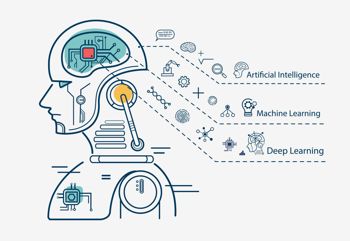
Robots?
We’ve long been promised - or warned, depending on your perspective – that robots will soon become a regular feature in care homes and nursing homes, helping to alleviate the staffing shortages our sector faces.
However, where care robots have been most heavily developed and trialed they have yet to take off. I’m talking of course about Japan. It was revealed that up to 2018 the Japanese government had ploughed over $300m into development and research for care robots.
Japan has its own acute crises in social care provision, with an aging population and more stringent policies restricting migrant labour.
Despite the enormous funding and interest, only 10% of social care providers had introduced any form of robotics into their care services. Reasons cited by care providers and experts in the field include robots actually creating new labour, and overall more work for care workers, rather than freeing them from tasks. Practical limitations, for example in robots that assist with lifting residents being uncomfortable.
Ironically, when the creator of ‘Robear’ (a discontinued robot designed to help lift care home residents) was asked if robots were a solution to Japan’s challenges in social care, he said that migrant labour was a better answer. Numerous experts have commented that paying care staff more would also help.
So for now it seems robotics is yet to find its place in care homes, perhaps in the future it may, but any successful use would have to recognize the distinctiveness of health and social care.
Deploying robots on assembly lines makes sense, they can do simple, manual tasks faster, constructing inanimate, duplicated objects. In is of course, the exact opposite of care, where everyone is unique and really, there is very little that a machine counterpart to a care worker could do better than a care worker (if that care worker has the necessary time, equipment, training and so on).
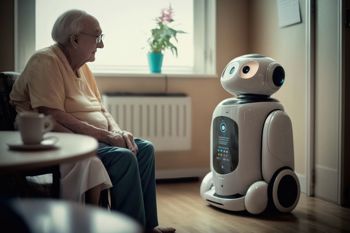
Managing medicines
Medication management software for care homes has come on leaps and bounds in recent years. Initially, at the end of the 1990’s, care home and nursing homes started transitioning from MAR charts to eMAR (simple, electronic MAR charts).
Since then these systems have been further developed and now help manage the entirety of medicines processes in care homes and nursing homes, including:
- Automation of processes such as medicine ordering
- Inventory functionality; stock control and counts, alerts on low stock etc.
- Integration with pharmacist’s systems for seamless ordering
- Reporting and analytics
- Remote monitoring of medication rounds
- Barcode scanning
- Medication review management
Of course each specific system may have different functionality. Some systems will also be better than others and this will impact the benefits you can expect from them.
Benefits
The main reasons providers implement digital medicine management systems is to simultaneously improve safety and make it easier, more efficient and more reliable to manage medicines processes.
Managing medicines using paper, or regular computer software that is not specifically designed for the job, leaves room for lots of risk. These could be risks caused by incorrect information, gaps in information, or parts of processes not being carried out or carried out properly.
Managing medicines properly also creates a lot of admin when using paper or normal office software, to audit, manage stock, records and so on.
Medicine management software ties up loose ends, uses automated alerts and process management and lots of other useful features to make medicines safer in your care service and reduce, or completely eliminate medicine errors.
Which is best?
There are around three or four leading software suppliers of medicine management software. The Access Group’s eMAR and medicine management software among them, but you should do some online searching and look at what the market has to offer.
But, regardless of whether you decide to use our software or another, ensure the supplier also has an integrated care planning component too. It is essential your medicine management software integrates with your care planning system as this example highlighted by NHSX/Digital Social Care shows:
One massive requirement for us was that any electronic records system and medicine management system needed to dovetail together. They needed that seamless integration. Access Group was able to provide us with this integrated system
It was our carers and managers who were most adamant about this, and when you think about the additional duplication of data entry and the potential for errors that using two separate systems create, they were and are absolutely correct to insist on an integrated system.
Our staff were saying they didn’t want to have to put residents’ details in half a dozen different places, we want to put it in once. That was our number one requirement and that came directly from our care staff
Digital Innovation and Technology In Care Homes – What’s next
In this article I’ve highlighted some of what I think are the best, most interesting examples of digital innovation in care homes right now.
Hopefully it has stimulated your interest and helped give you an introduction to these exciting new developments.
As you may have noticed, lots of the newest emerging technologies maximise their impact exponentially when used together, for example when the data from wearable tech, acoustic monitoring, digital care notes, observations and so on can be processed (with or without machine learning) to deliver practical insights for care staff and managers.
These can take the form of alerts and early warnings. Or on the positive side, clear progress towards aimed for outcomes, better wellbeing and a clearer understanding of how and why those outcomes have been achievable for that individual, and across a cohort.
At The Access Group we want to be with you at the forefront of this new age of care home technology. Our care home management software is already used in thousands of residential care settings across the UK.
We’re building on those foundations to equip our clients with advanced analytics and new technology to help bring together the data, and the potential benefits offered by all these new devices and computational
We would of course love for you to be on that journey together with us tomorrow, or better yet today. So if you’re interested in what we can do already, then just get in touch now. But if you’re not ready yet, or the timings not quite right, just stay tuned with the updates from Access and I’ll have more exciting updates to share with you very soon.

 AU & NZ
AU & NZ
 SG
SG
 MY
MY
 US
US
 IE
IE
